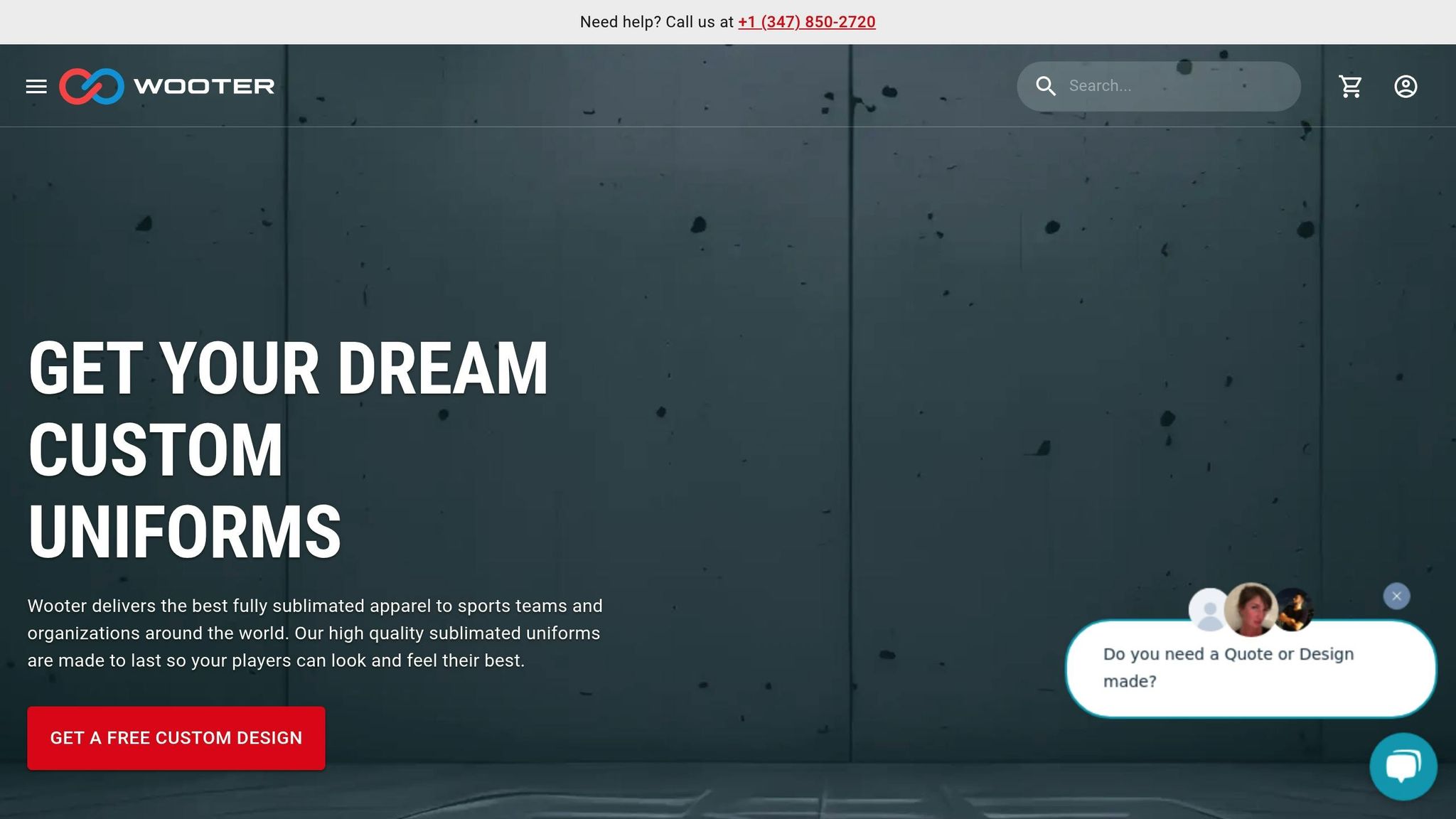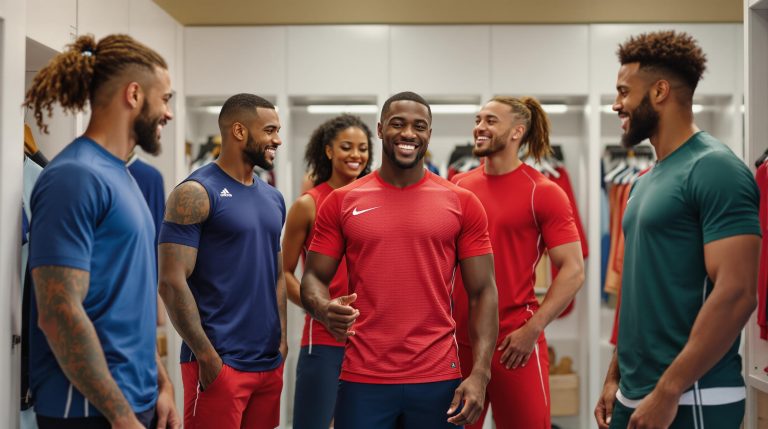Team uniforms can face common problems like poor material quality, inconsistent designs, sizing issues, and high costs. These challenges can affect performance, comfort, and team identity. Here’s how to tackle them:
- Material Quality: Use durable fabrics like performance polyester or interlock mesh to prevent wear and tear.
- Design Consistency: Opt for sublimation printing to ensure vibrant, long-lasting colors and uniform designs.
- Sizing Issues: Conduct team fitting sessions and use size charts to ensure proper fit for all players.
- Cost Management: Streamline bulk orders by using spreadsheets and sizing kits to reduce errors and manage expenses.
Quick Solutions Overview
| Problem | Solution | Why It Works |
|---|---|---|
| Material Quality | Choose durable fabrics | Prevents wear, improves comfort |
| Design Consistency | Use sublimation printing | Ensures vibrant, uniform colors |
| Sizing Issues | Team fitting sessions, size kits | Reduces returns, ensures proper fit |
| Cost Management | Bulk order planning | Simplifies ordering and saves money |
By addressing these issues with modern techniques and careful planning, you can create uniforms that look great, feel comfortable, and last longer.
How to Design Your Custom Team Jersey
Why Team Uniforms Break Down Too Fast
Team uniforms often don’t last as long as they should, thanks to outdated printing methods and subpar fabric choices. These problems not only affect the look of the uniforms but can also increase costs over time.
The main culprits? Traditional printing methods like screen printing and heat transfer. These techniques apply designs as a surface layer, which can crack or peel with use. On top of that, low-quality fabrics may not hold up to the physical demands of high-contact sports. The solution lies in better printing techniques and stronger materials.
How Sublimation Printing Improves Durability
Sublimation printing offers a longer-lasting solution by embedding the design directly into the fabric. This makes the design part of the material itself, eliminating the risk of peeling or cracking. The result? A smoother, more comfortable uniform with bold, vibrant colors that stay intact over time.
Choosing the Right Materials
The fabric you choose plays a huge role in how long uniforms last. High-performance fabrics are designed to withstand wear and tear. For example, interlock mesh fabric adds extra strength, while polyester blends combine durability with comfort.
| Material Type | Weight Range | Benefits |
|---|---|---|
| Performance Polyester | 140-280 GSM | Moisture-wicking, tear-resistant |
| Interlock Mesh | 180-220 GSM | Breathable, holds its structure |
| Poly-blend Fabrics | 160-240 GSM | Durable yet flexible |
The best fabric weight depends on the sport. Heavier materials (220-280 GSM) work well for high-contact sports, while lighter options (140-180 GSM) are better for activities that require more movement.
How Bad Fabric Choices Hurt Player Performance
Choosing the wrong fabric can directly impact how well athletes perform. Some professional uniforms have faced criticism for looking cheap and feeling stiff, with athletes complaining about their papery texture. These issues don’t just affect appearance – they also interfere with comfort and athletic ability.
When uniforms don’t perform well, they can lead to:
- Limited range of motion
- Excessive sweating
- Problems with temperature control
- Discomfort that distracts players during games
This highlights the importance of selecting fabrics designed specifically for athletic needs.
Moisture-Wicking Materials Keep Players Cool
Cotton can hold up to 7% of its weight in sweat, which makes garments heavy, soggy, and restrictive.
Modern moisture-wicking fabrics are designed to:
- Pull sweat away from the skin to the fabric’s surface
- Dry quickly to avoid saturation
- Keep the skin feeling dry and comfortable
- Help regulate body temperature effectively
Using these advanced materials can make a big difference in both team performance and comfort.
Sport-Specific Design Features That Matter
Different sports demand specific fabric characteristics. Here’s a breakdown:
| Fabric Type | Performance Benefits | Best For |
|---|---|---|
| Performance Polyester | Lightweight, durable, and moisture-wicking | High-intensity sports |
| Nylon Blends | Stretchable (up to 40%), water-resistant | Contact sports |
| Merino Wool | Breathable, odor-resistant, and moisture-wicking | Outdoor sports |
| Elastane Blends | Provides excellent stretch | Activities needing full motion |
“In clothing, performance fabrics are used to create garments that enhance the wearer’s intended activity. In activewear, this includes fabrics that are antimicrobial, durable, lightweight, moisture-wicking, mold-resistant, stain-resistant, thermoregulating, breathable, and stretchable.”
- Meredith Maier
Recent advancements in fabric technology are changing the game. For instance, Nuyarn technology offers 85% more stretch compared to standard wool. Similarly, Repreve production reduces energy usage by 32% compared to traditional polyester, all while maintaining high-performance standards.
sbb-itb-4d95ad3
Fixing Color Match and Fading Problems
Color issues like mismatched shades and fading can affect team uniforms’ overall look. Here’s how to maintain vibrant colors and prevent fading over time.
Keeping Colors Consistent with Sublimation
Sublimation printing embeds dye directly into fabric fibers, resulting in vibrant colors that last. Here’s why it’s a go-to method:
- Colors resist cracking, peeling, and fading over time.
- Ensures uniform color across all pieces.
- Stands up to repeated washing.
- Maintains brightness for extended periods.
To keep these colors looking fresh, proper care is key. Wash uniforms inside out in cold water (no warmer than 86°F or 30°C) with a gentle detergent made for colored fabrics. Always dry them in the shade, as direct sunlight can cause fading.
For extra protection, consider these methods:
| Method | Benefit | How to Apply |
|---|---|---|
| UV-Block Treatment | Shields fabric from UV damage | Added during manufacturing |
| Cold Water Washing | Helps preserve color integrity | Routine maintenance |
| Shade Drying | Reduces sun-related fading | Part of post-wash care |
It’s also crucial to confirm colors before production begins. Ensuring digital accuracy prevents inconsistencies across uniform batches.
Reviewing Digital Proofs for Accuracy
Getting the colors right from the start avoids production errors and keeps everyone happy. Many teams rely on the Pantone color system to ensure consistent shades across all uniform elements. Follow these steps to verify accuracy:
- Choose precise colors using verified codes and swatches. Reference your team’s brand guidelines and exact Pantone numbers, if available.
- Carefully review digital proofs before production. Look for consistent color matching across all pieces, accurate logos and graphics, and correct primary and accent shades.
Advanced color management systems, like ICC profiles tailored for sublimation printing, ensure accurate reproduction across different materials. When combined with good care practices, these steps keep uniforms looking sharp all season long.
Getting the Right Uniform Fit
The right uniform fit not only enhances comfort but also improves team performance while reinforcing your brand identity. On the flip side, poorly fitting uniforms can hinder performance. Proper planning is key to avoiding these issues.
Team Fitting Sessions Before Ordering
Organizing a fitting session ensures everyone gets the right size. Here’s how to make it effective:
1. Schedule a Dedicated Fitting Day
Set aside a specific day when all team members can attend. This ensures consistent measurements and fittings.
2. Use Professional Measuring Tools
Accurate measurements are crucial. Focus on these key areas:
- Bust/chest
- Arms
- Waist
- Hips
- Inseam
3. Record Measurements
Keep detailed records, including:
- Player names
- Jersey numbers
- Chosen sizes
- Special size requirements
Note: Finished garments may vary slightly, typically by +/-5%.
These measurements will help you compare sizes more effectively and evaluate test samples with confidence.
Using Size Charts and Test Samples
Size charts and test samples are your best tools for ensuring a good fit. Here’s how to use them:
- Compare measurements to similar garments that already fit well.
- Decide on the fit style (relaxed or fitted).
- Use gender-specific charts when available.
- Check if sizes tend to run small, large, or true to size.
| Measurement Type | What to Consider | Why It Matters |
|---|---|---|
| Garment Size | Compare to existing well-fitting uniforms | Ensures consistency in sizing |
| Body Measurements | Use a measuring tape for accuracy | Reduces returns and exchanges |
| Fit Preference | Allow 1-2 inches for movement | Keeps players comfortable in action |
For bulk orders, consider requesting sizing kits. These kits:
- Allow players to try on samples, reducing ordering mistakes.
- Are refundable when returned in full.
- Help ensure consistent sizing across the team.
If someone falls between sizes, it’s usually better to size up slightly. This allows for easier adjustments while still maintaining a polished, professional look.
Making Uniforms Match Team Identity
Designing uniforms that reflect your team’s brand takes careful planning and attention to detail. Beyond just the fit, aligning your uniforms with your team’s identity strengthens both performance and branding.
Custom Design Tools at Wooter Apparel

Using high-quality materials and printing is only part of the equation. Precise design tools are essential to create a look that feels professional and cohesive:
- Vector Graphics for Sharp Logos: Always use vector files (.ai or .pdf) to ensure logos stay crisp, no matter the size.
- Color Consistency: Pantone codes help maintain accurate colors in high-resolution prints.
| Design Element | Best Practice | Solution |
|---|---|---|
| Logo Format | Vector files (.ai/.pdf) | Prevents pixelation |
| Color System | Pantone codes | Avoids color mismatches |
| Design Style | Simple, readable layouts | Improves visibility |
| Font Choice | Legible fonts | Ensures readability |
Adding Custom Team Details
Customizing your uniforms with unique details helps amplify your team’s identity:
Optimal Placement
- Team names on the chest
- Secondary logos on the shoulders
- Branding on the side panels
- Player names and numbers on the back
Key Customization Elements
- Player Identification and Recognition: Make sure numbers are easy to spot. You can also add special touches like championship patches or team mottos.
- Uniform Accessories: Extend your branding to additional items, such as:
- Warm-up gear
- Equipment bags
- Team hats
- Practice uniforms
Consistency is crucial. Every detail should contribute to a uniform look that represents your team.
Conclusion: Steps to Better Team Uniforms
Creating great team uniforms requires focusing on a few key aspects. Here’s a quick summary of strategies to tackle common challenges.
Start by designing with Pantone codes and vector logo files for precision. You can either submit your own designs or collaborate with professionals for expert input.
Choose durable materials and go for sublimation printing to get vibrant colors that last. This method allows for unlimited color options and ensures the uniforms stand up to wear and tear.
Getting the right fit is just as important for comfort and performance. To make sure your team is ready:
| Step | Action | Why It’s Important |
|---|---|---|
| Size Verification | Use sizing kits | Guarantees proper fit for everyone |
| Roster Management | Provide detailed spreadsheets | Simplifies the ordering process |
| Quality Check | Review design proofs | Avoids costly mistakes |
Beyond sizing, customization at affordable prices can make a big difference. For example, basketball jerseys start at $19.99, while soccer jerseys are available from $13.99. In March 2025, the Circle City Flyers softball team worked with professionals to create uniforms that truly stood out.
By following these steps, you’ll end up with uniforms that not only look great but also support your team’s performance.
“Our custom sports uniforms are crafted to match your team’s exact brand requirements.”

